Transforming Learning Spaces: Buy Interactive Panels for Schools in Texas
- alonzo alaniz

- 6 days ago
- 7 min read

At Platinum Consulting Services (PCS), we help schools modernize instruction with classroom technology that simply works. At PCS, our goal is simple: make learning more dynamic with smart tools that improve outcomes, save teachers time, and deliver long‑term value.
If you're planning to buy interactive panels for schools in Texas, this guide breaks down what to look for, how to budget, and how to roll out devices the right way for your campuses.
Why Interactive Panels Matter For Texas Classrooms

Interactive panels combine a touch display, computer, and digital whiteboard into one easy device. For Texas classrooms, they replace aging projectors and boards with brighter visuals, simpler setup, and interactive lessons students love.
Explore our classroom technology solutions to see how we simplify daily instruction.
Instructional Impact Aligned To TEKS and UDL
PCS helps Texas teachers align interactive lessons with Texas Essential Knowledge and Skills (TEKS) and Universal Design for Learning (UDL) principles by designing lesson flows that emphasize inquiry, analysis, and communication.
Teachers can layer standards-based objectives onto manipulatives, videos, and simulations. For example, in Grade 5 science, students can annotate life cycle diagrams directly on the panel: in Algebra I, they can graph and compare functions in real time, then export notes to Google Classroom or Microsoft Teams. This turns traditional lessons into interactive experiences that connect with how students learn best.
Student Engagement, Accessibility, And UDL
Interactive classroom panels support Universal Design for Learning (UDL) principles. Multi-touch interaction encourages collaboration, while built-in accessibility tools such as magnification, captions, and color-contrast modes make lessons inclusive for all learners.
We’ve seen reluctant readers participate more when they can use text-to-speech, highlight key ideas, or write directly on the screen. With wireless casting, even students in the back row can share from their own devices, spreading engagement beyond the “front-row few.”
Data-Driven Teaching And Collaboration
Modern panels come with polling, quizzes, and real-time feedback features. Teachers can instantly see what concepts are landing and what needs reteaching.
Split-screen mode, infinite whiteboarding, and screen sharing allow groups to co-create and present, saving hours of after-school differentiation work. It’s collaboration and assessment, built into instruction.
Key Features And Specs To Compare

When evaluating educational technology solutions, focus on specs that make a daily difference for teachers and students.
Size And Viewing Distance By Room Type
Most classrooms perform best with 75–86 inches displays so every student in the back row can see clearly. Smaller rooms or conference spaces can use 55–65 inches. As a quick rule, the panel’s width should be about half the distance to the back row.
Touch, Pens, And Palm Rejection
Look for 20-point multi-touch, reliable palm rejection, and dual-pen support so two students can write at once. Active pens with fine tips and color options make annotation smoother and more accurate for math, science, and diagram work.
Display Quality, Audio, And Durability
Look for 4K resolution, anti-glare glass, and 350–400 nits brightness to keep content visible under Texas sunlight. Front-facing speakers (or a simple soundbar) improve audibility without external amps. Panels built with aluminum frames and scratch-resistant glass will handle daily classroom use.
Embedded OS, Software, And App Ecosystem
An embedded OS with robust whiteboarding, screen capture, and built-in manipulatives saves teachers setup time. Ensure compatibility with your LMS and SSO, Google, Microsoft, and Clever. Access to vetted educational apps and web tools means teachers don't have to reinvent lessons: they adapt what they already use.
Connectivity, Security, And Remote Management
Modern panels should offer HDMI and USB-C with power delivery, Wi-Fi 6, and secure wireless casting. For IT, insist on remote management, firmware updates, device health monitoring, and role-based permissions for safe, smooth operation.
Matching Panels To Grade Levels And Learning Spaces
Different spaces call for different configurations. We design around instructional goals first, then select hardware that fits.
Our education technology consulting team designs each setup around your instructional priorities.
Early Learning And Elementary Priorities
Younger students benefit from larger icons, simple whiteboarding, and sturdy mobile carts that bring the panel down to student height. Dual pens, handwriting recognition, and built-in manipulatives (ten-frames, clocks, shapes) make lessons engaging and developmentally appropriate.
Middle And High School Use Cases
Secondary teachers need fast switching between sources, reliable inking for math and science, and easy media playback for ELA and social studies. Multi-window mode is useful for side-by-side document analysis. For CTE courses, USB-C with power delivery supports fast laptop connections.
STEM Labs, Libraries, And SPED Considerations
Labs pair panels with document cameras for live demos. Libraries often use 86-inch displays for visibility. SPED rooms benefit from height-adjustable carts, rugged pens, and accessibility-friendly software that supports text-to-speech and visual schedules.
Budgeting, Procurement, And Compliance In Texas

We help districts right-size budgets and stay compliant while maximizing instructional impact.
PCS also provides school purchasing and funding support to help Texas districts maximize every dollar.
Pricing Tiers And Total Cost Of Ownership
Entry panels can be cost-effective for small rooms, while mid-tier models balance features and longevity for most classrooms. Premium options add advanced audio, better glass, and extended warranties. Consider total cost of ownership: mounts/carts, cabling, training, spares, and remote management. Durable gear plus teacher coaching usually beats buying more units with less support.
Texas Purchasing Cooperatives (DIR, BuyBoard, TIPS)
Texas public, private, and charter schools can streamline procurement through DIR, BuyBoard, and TIPS, reducing bid cycles and ensuring vetted vendors. Our team aligns quotes with your district's purchasing thresholds and approval steps.
Funding Sources Post-ESSER And Grants
As ESSER sunsets, we help schools braid funding: Title I for equity and interventions, Title IV for well-rounded and safe learning, Perkins for CTE, and local bonds. Don't overlook regional grants or foundation mini-grants for pilot rooms. We can package proposals with evidence-based outcomes and cost breakdowns.
Warranties, SLAs, And Lifecycle Planning
Choose 5-year on-site warranties with rapid replacement options. Establish an SLA for response times, loaner units, and firmware updates. We map a 6–8 year lifecycle, with a rotation plan for high-use rooms and spares to cover damage during testing seasons.
Installation, Networking, And Classroom Readiness
Simple integration, powerful results, that's the goal. Our deployments are built for the demands of real classrooms.
Mounts and Mobility:
Fixed wall mounts clean up cables and maximize space. Mobile carts support shared rooms, PD spaces, and small group pull-outs. Height-adjustable carts improve ADA accessibility and serve SPED settings. We survey stud walls, power, and sightlines so every student can see and reach the screen.
Power and Network Integration
We coordinate electrical drops and PoE accessories, ensure stable wired or Wi‑Fi 6 connections, and test casting from Chromebooks, iPads, and Windows devices. USB‑C brings one-cable simplicity for teacher laptops. Document cameras, webcams, and microphones round out hybrid learning and assessment days.
Privacy And Safety
We configure panels to respect district content filters and SSO policies. Admin pin codes, screenshot privacy, and automatic logouts keep student data secure.
Teacher Training, Coaching, And Rollout
Hardware alone doesn’t transform instruction, confident teachers do. Platinum Consulting Services (PCS) provides quick-start guides, just-in-time coaching, and mentoring cycles aligned to your district’s instructional model.
We recommend a phased rollout: pilot → refine → scale. Early adopters become local champions who share success stories and tips.
Local Buying And Support In Texas
When you buy interactive panels for schools in Texas, local logistics and environment matter.
See schools we support in the Rio Grande Valley for examples of successful deployments.
Lead Times, Delivery, And On-Site Support
We plan around testing calendars, construction windows, and summer projects. Our team coordinates delivery, asset tagging, and e-waste removal statewide. If a unit needs service, our regional support network minimizes downtime.
Environment and Maintenance
Texas environments from humid coastal regions to dusty West Texas require practical care: sealed ports, proper cable management, and periodic cleaning. A quarterly firmware and health check extends panel life and stability.
Pilot Plan: Demo Checklist, Feedback, And Metrics
Before district-wide adoption, we help run a pilot. Our demo checklist covers size fit, brightness, inking, casting reliability, app access, and LMS integration. We collect teacher/student feedback and track metrics like setup time, usage minutes, and formative data capture. Those insights inform final model selection and training plans.
Conclusion

If you're ready to buy interactive panels for schools in Texas, we can help you choose the right size, feature set, and rollout plan, then stand behind it with training and support. As a trusted advisor, PCS designs solutions that make teaching easier and learning more engaging.
Looking to upgrade your classrooms? Contact PCS for a custom technology plan tailored to your campuses.
Explore our services and see who we serve across Texas schools.
For insights and success stories, visit the PCS blog.
Prefer a hands-on look? Request a free demo or quote today. We’re here to help your classrooms thrive!
Frequently Asked Questions
When you buy interactive panels for schools in Texas, what screen size should you choose?
Most Texas classrooms benefit from 75–86-inch panels so students in the back can read small text. Smaller rooms or conference spaces can use 55–65 inches. A quick rule: pick a display width about half the distance to the last row for clear readability and lesson visibility.
How do interactive panels support TEKS and student engagement in Texas classrooms?
Panels enable standards-aligned lessons with inquiry, analysis, and communication. Teachers can annotate diagrams, graph functions in real time, and export notes to Google Classroom or Microsoft Teams. Multi-touch, captions, magnification, and color-contrast modes support UDL—boosting collaboration, accessibility, and participation from reluctant readers and diverse learners.
Which Texas purchasing co-ops and funds can schools use to buy interactive panels?
Texas districts and charter schools can streamline procurement via DIR, BuyBoard, and TIPS for vetted pricing and faster compliance. Post-ESSER, districts often braid Title I, Title IV, Perkins (for CTE), local bonds, and regional grants. Build proposals with evidence-based outcomes, training, and total cost of ownership.
How much do interactive panels cost for schools in Texas, and what affects pricing?
Typical K–12 panels range roughly $2,500–$6,500 per classroom, depending on size (55–86”), inking quality, audio, glass, warranties, and remote management. Budget for mounts/carts, cabling, training, spares, and deployment. Durable hardware plus teacher coaching usually delivers better outcomes and lowers total cost than buying more units with less support.
Are interactive panels better than projectors for school instruction?
For most classrooms, yes. Panels offer brighter 4K visuals, no bulb replacements, instant-on, precise inking, and built-in tools like whiteboarding, polling, and wireless casting. They reduce setup friction, support collaboration, and maintain visibility in daylight—advantages over projectors, which can suffer from glare, shadowing, and ongoing maintenance.





Comments